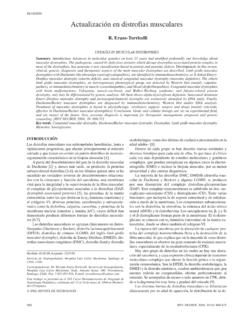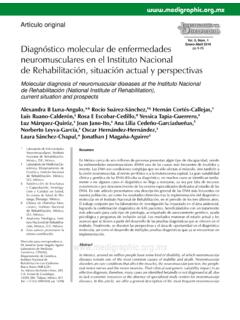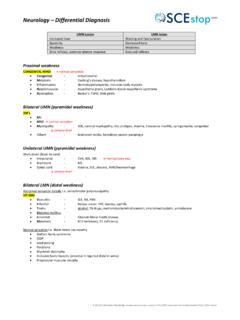Transcription of A Guide for Patients & Physical Therapists - FSH …
1 Physical therapy & FSHD Facioscapulohumeral muscular Dystrophy Authors: Wendy M. King, , Assistant Professor, Neurology &Shree Pandya, , , Assistant Professor, Neurology & Physical Medicine and Rehabilitation A publication of the FSH Society, Inc. A Guide for Patients & Physical Therapists Table of Contents Introduction ..4 Facioscapulohumeral Dystrophy (FSHD) ..5 Manifestations of Impairments Related to FSHD ..5 Exercise and FSHD ..7 Hydrotherapy (Water therapy ) and FSHD ..9 Pain and FSHD ..9 s ..11 Surgical Management of Scapular ProblemWho Are Physical Therapists &What Can You Expect When You See Them? ..12 To Physical Therapists ..14 Treatment of Pain ..15 Summary ..16 References ..17 About the FSH Society ..18 Contact Information ..19 3 Introduction he purpose of this Guide is to assist Physical Therapists and Patients to develop an individualized plan of care based on the best research evidence, clinician expertise and patient T preferences.
2 The go plan of care are to als of any Physical therapy assist Patients to: ations Maintain optimum health Prevent/Delay secondary complicMaximize functional abilities Improve/Maintain quality of life Based on the patient s needs, the therapist s role may be that of a consultant, educator, and/or hands on service provider. Depending on the patient s signs and symptoms and functional limitations, the individualized plan may include recommendations about appropriate activities, exercises, modalities for pain relief, orthotics, adaptive devices and/or home modifications. We have emphasized individual plans of care rather than specific recommendations because FSHD, unlike some of the other muscular dystrophies, is a very heterogeneous condition Patients can present with a specific combination of muscle involvement and progress at a specific rate that is unique to them.
3 There is extreme variability relative to age of onset, n. degree of weakness and rate of progressioThis Guide is designed to supplement and complement information available from other lay and professional organizations. We hope that the information provided here will assist Therapists and Patients to work together to meet individual needs. We look forward to your feedback to help us improve and update our recommendations. We dedicate this Guide to Stephen Jacobsen, for his unfailing commitment to the work of the FSH Society and support of this publication. This Guide was paid for by the FSH Society under an FSH Society Delta Railroad Construction Grant. 4 Further contributions and comments were provided by the FSH Society, Inc. Scientific Advisory Board, and the FSH Society, Inc. Board of Directors.
4 Facioscapulohumeral Dystrophy (FSHDD is an inherited degenerative disorder of uscles with prominent involvement of les of the face, shoulder girdle and upper arm SHmmuscearlyIt is ain vircarrieF ) in the disease. n autosomal dominant disorder meaning that tually all cases an affected individual who s the genetic abnormality that causes FSHD has a 50 50 chance of passing the disorder onto each offspring. The vast majority of inherited cases are linked to a genetic lesion on chromosome 4 (4q35). However, the FSHD genomic mechanism arising from that lesion is unknown. Most individuals seek medical attention in the second decade due to increasing difficulties with overhead activities or activities such as climbing stairs and walking on uneven surfaces. A small minority may not notice muscle weakness and, at the other end of the spectrum, a small percentage of individuals are diagnosed in the first decade.
5 Earlier onset is associated with a larger piece of missing DNA and a faster progression of weakness. Manifestations of Imp 5 In an FSHD natural history study (a study that attempts to define the typical characteristics of a disorder and changes over time) the findings showed the weakest muscles were the muscles that connect the shoulder blade to the spine in the upper back (scapular stabilizers), the shoulder muscles that rotate the arm outward (external rotators), the chest muscles (pectorals), the muscles that bend the elbow airments Related to FSHD SHD, as the name implies, initially affects muscles of the face (facio), shoulder blade (scapulo) and upper arm (humeral) muscles. However, in addition to the face, shoulders and upper arms, other skeletal muscles are sometimes affected severely. Specifically, muscles around the hips (pelvic girdle), on the back of the thigh (hamstring group), stomach (abdominal), and on top of the ankle that pull the foot up towards the head (ankle dorsiflexors), can develop significant weakness early in the disease F 6 appropriate Associated non skeletal muscle manifestations include high frequency hearing loss as well as retinal telangiectasias, both of which are rarely Approximately half of the Patients present with subclinical high tone hearing loss and Hearing loss is often more severe in infantile onset FSHD and if not detected (biceps and brachioradialis), the muscles that bend the knee (hamstring group), and the muscles that bend the foot up (ankle dorsiflexors).
6 In this same study, most individuals stated that their first symptoms occurred during their teens, but it was several years before they sought and/or received a diagnosis. The weakness in the majority of Patients progresses very slowly and a significant decline in strength could only be documented after .2 twelve months of following a group of 90 patientsGenerally, FSHD displays a characteristic gradual spread of muscle involvement, starting in the face and slowly progressing to the shoulder and upper arm musculature and to the abdominal and foot extensor Foot dorsiflexion weakness leading to foot drop is an early manifestation of FSHD and one amenable to the use of molded ankle foot orthoses (AFO).14 The most common initial symptom is difficulty reaching above shoulder level. Foot drop is a less common symptom; such Patients , however, almost always have compensated asymptomatic scapular fixator and facial weakness on examination.
7 Truncal weakness is an early and frequent manifestation that is easily overlooked during examination of Patients . Weak abdominal muscles result in a protuberant abdomen and contribute to lumbar lordosis. Lower abdominal muscles are weaker than the upper abdominal muscles, causing a strikingly positive Beevor s sign, a Physical finding fairly specific for Mild to severe bilateral sensorineural hearing loss and abnormal blood vessels within the eye can be associated with FSHD. Usually these features are asymptomatic (meaning the affected person is not aware of the abnormality), but individuals with these complications should be followed by the and treated early can interfere with learning and cognitive development. Audiograms should be performed on all Patients diagnosed with infantile Cardiac involvement that causes symptoms is uncommon in FSHD, but individuals should be Likewise, serious respiratory involvement can occur in FSHD, although often late in the disease Persons with FSHD should ask their physician as to appropriate respiratory 7 rcise and FSHD lthough there have been many studies that examined the effect of exercise in neuromuscular disease, these typically combined individuals with various disorders (only a few of which were FSHD) and were short term studies (three months or less).
8 Only one study has involved exclusively FSHD subjects and was 12 months in Because of these limitations, it is difficult to extrapolate many conclusions for the FSHD community. But in general, no negative effects were observed in studies that involved aerobic exercise6 (exercises designed to temporarily increase heart rate and respiration), and few negative effects have been observed in studies looking at resistive exercise (exercise using any type of weight or resistance). The only 12 month study concluded that: A monitoring. Symptoms and signs of respiratory insufficiency should be sought during routine clinic visits in Patients with moderate to severe FSHD. Regular monitoring of respiratory function is suggested; one might experience insufficiency without presenting signs over a long period of time.
9 Symptomatic respiratory insufficiency can be initially managed with nighttime non invasive pressure support ( , a BiPAP machine). In very severe cases, Patients may require the use of a ventilator. In standard practice, trauma (ER, ICU), surgery and anesthesiology settings, care should be taken not to suppress respiratory drive with narcotics unless it is a situation of palliative care. Oxygen supplementation can be detrimental to Patients with hypercarbic (high CO2) respiratory failure. A physician/pulmonologist can help to periodically monitor CO2 levels. Exe 8 exercises to their daily routine. However, in the case of Duchenne muscular dystrophy and at least some of the limb girdle muscular dystrophies, resistive exercise can lead to hastened muscle weakness. Because the FSHD genomic mechanism arising from the 4q35 contraction lesion is unknown, no one can say with On the basis of our experience in this trial we tell our FSHD Patients that normal participation in sports and work appears not to harm their On the other hand, there is insufficient ground for general prescription of exercise programs in FSHD.
10 5 There are two chief concerns in regard to individuals with FSHD performing resistive exercise. First, individuals with FSHD usually have striking differences in muscle strength among different muscle groups. It is difficult to safely exercise a strong or only mildly weakened muscle without risking overuse or stretch injury to a much weaker muscle that is also involved in performing the The second concern is that depending on the degree of weakness of a person with FSHD, some muscles may be working (exercising) to their maximum just to perform activities of daily living (ADL) against the force of gravity. A weak scapular (shoulder blade) stabilizer muscle such as the serratus anterior or middle trapezius for example, will be challenged to complete daily showering, hair washing, and hair combing tasks.






